
Undeterred by controls, Pt. Pedro celebrates tradition
[TamilNet, Thursday, 17 April 2003, 13:40 GMT]
Pt. Pedro is the oldest harbour town on the Jaffna peninsula’s sea coast. The Portuguese called the town Puntas das Padras (rocky point) on account of the reefs that line its coast. Tamils, however, still refer to it by its old name Paruththithurai (cotton port in Tamil). This week the townspeople celebrated the annual chariot and water cutting festivals of one of their old temples that have lain long and neglected inside the SLA’s high security zone in Pt. Pedro.
The Sri Lanka army continues to occupy the old but most important quarter of the town including the harbour despite the year long ceasefire between Colombo and the Liberation Tigers.
In 1985 the army burnt the valuable library of Hartley College in Pt. Pedro - one of Sri Lanka’s most prestigious schools.
A large part of the town’s old quarter was taken over by the army that year.
 cut out of the goddess Amman in the town centre
cut out of the goddess Amman in the town centreThe Pt. Pedro district and magistrate courts, the old customs building, the main post office, the harbour and its large storage facility, the town’s urban council building, fuel depot, rest house, judge’s quarters and the Pt. Pedro Multi Purpose Co-operative Society building and its stores, along with three Tamil temples and the town’s 19th century Methodist Church were taken over by the SLA in 1985.
Many of these buildings and more than 200 houses in this densely built up area were damaged or destroyed in the war between 1985 and 1987. The Indian army occupied the harbour-Hartley College sector from 1987 to 90.
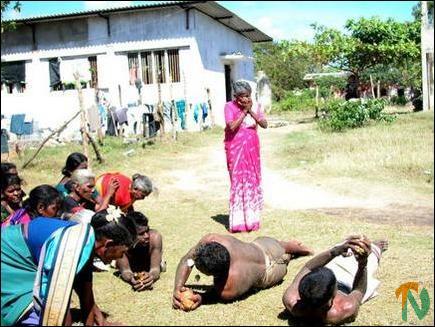 devotees near SLA barracks by the temple
devotees near SLA barracks by the templeThe SLA occupied a larger area in Pt. Pedro than it did in 85-87 when it took control of the peninsula in 1996. All public and private properties in College Road, V. M Road, Police Station Road, Beach Road, Harbour Road and the 1st and 2nd Cross Streets are still occupied by the military.
The Pt. Pedro harbour was the main supply point for civilian goods to the peninsula from 96 to 2001. Today, after the opening of the A9 highway to Jaffna last year, only refugee relief and the Ramco brand cement from India are unloaded at this port. But security is still tight. Only 10 Lorries at a time are allowed to the harbour after checking; and only labourers with special permits issued by the SLA are allowed there.
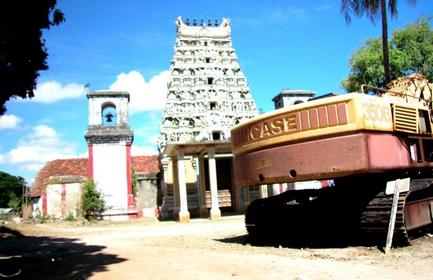 army heavy machinery parked in front of Kottadi Pillaiyar temple
army heavy machinery parked in front of Kottadi Pillaiyar templeHartley College is still part of the SLA’s large high security zone in Pt. Pedro. Several buildings of Hartley College were occupied by the military until last year. The Pt. Pedro Methodist Girls’ High School too is inside the HSZ.
Historians say that the origins of Hartley College can be traced back to a 17th century school run by the Dutch Reformed Church in Pt. Pedro. In the early 19th century Wesleyan missionaries developed into a full fledged school.
Simon Casie Chetty in his ‘The Ceylon Gazetteer’ published in 1834 says that Pt. Pedro was “a large village and parish of Jaffna, in the province of Wadamarachy (sic), situated in the northern extremity of the island, having 8381 inhabitants. It is called by the natives Parettitore, or cotton Harbour, from the great quantity of cotton formerly produced here. The village … possesses a fine harbour where vessels find safe anchorage. It is the station of a magistrate and An assistant custom master, and carries on a considerable trade with Madras, and other places on the Coromandel coast; exporting Palmyra timber, and importing grain, cloth etc.,
“Here was formerly a handsome church built by the Dutch, and when Baldaeus visited in 1661, numbered 300 auditors (sic), besides 1000 children, who were taught in the school attached to it; but it has lately been demolished, and the Hindoo (sic) religion has regained its predomoninancy (sic). The Wesleyan Missionaries have however formed an establishment and erected a chapel, and the Roman Catholics too have their place of worship at Pt. Pedro. In a war between the Dutch and English, the former built a fort here, but scarcely a vestige of it remains at present”. (The Ceylon Gazetteer, 1834, pp. 186-87)
Protests by the school children last year saw the gradual easing of the army’s stringent restrictions on entering the HSZ to worship. Only a few devotees were permitted to enter the zone for the chariot and water cutting festival of the Koattu Vaasal Amman Kovil and the Kottadi Pillaiyar Kovil in 2001.
Families associated with the latter say that it was erected at the site where the Portuguese had destroyed a temple in the 16th century. The statue of the god Pillaiyar was smuggled to Pt. Pedro from Vethaaranyam in South India, hidden in a vat (Kottu) of sugar and around mid 19th century the local community built a temple for the image. Locals say the temple has one of the earliest Gopuram (pinnacle style) structures in Jaffna.
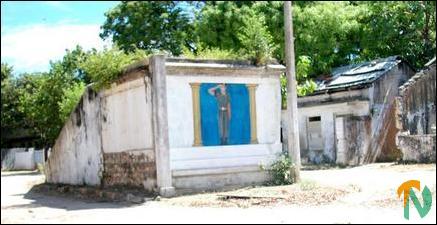 Kottadi temple chariot platform
Kottadi temple chariot platformKottadi Pillaiyar Kovil’s ceremonial pond (Theppakkulam) is yet behind concertina rolls.
This year access was unrestricted for the Amman Kovil festival– the sentries questioned some devotees whom it found suspect at the entry point to the HSZ.
Hundreds of devotees thronged the Koattu Vaasal Amman temple Tuesday and Wednesday for the first time since the SLA made it part of its large garrison in this northern port town. The traditional Tamil customs of fulfilling vows to the gods are severe, particularly in times of hardship and suffering.
Many devotees rolled on the ground around the temple in the scorching sun, their cheeks pierced by mini spears, to fulfil their vows to the goddess. One swung himself by hooks fastened to his back.
A makeshift chariot was pulled round the temple, along a corridor defined by SLA concertina rolls, sentry points and military barracks. The temple’s old intricately carved wooden chariot was destroyed in the war. Only its base remains, battered by the elements. An SLA soldier’s image is painted on the platform of the Kottadi Pillaiyar Temple’s chariot.
On Tuesday night more than a thousand devotees gathered in the heart of the town to listen to devotional hymns and the Bow Song (Villuppaattu) by Sinnamani.
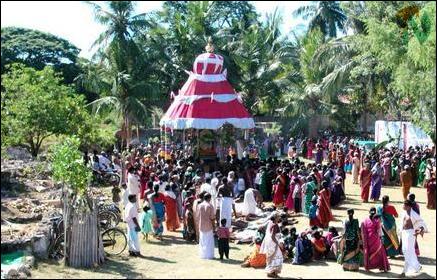 Amman temple's makeshift chariot
Amman temple's makeshift chariotThe section of the town centre not occupied by the military was gaily decorated for the festival after many years. A local artist painted a giant image of the temple’s warrior goddess seated on a growling Tiger and erected it in the town centre, facing the military’s high security zone.
Many families of the town that had fled the war in search of safety in the west had returned to Pt. Pedro last week in time for the Koattu Vaasal Amman Kovil festival.
One of them who went abroad in 1985 after the army went on a destructive rampage in his neighbourhood on Police Station Road and V. M Road said, “Wherever we are, our family and community are bound by this temple and its festival. It is the focal point that keeps us from melting into an ‘identityless’ mass in the west. The festival rejuvenates our ties to this soil.”
“Our bonds to this town survived persecution by the Portuguese and the Dutch. Therefore I don’t think we would just melt away because the army wants to stay here indefinitely” he said.
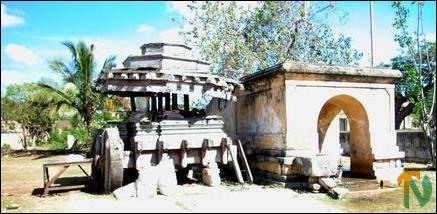 remains of the old wood carved chariot
remains of the old wood carved chariot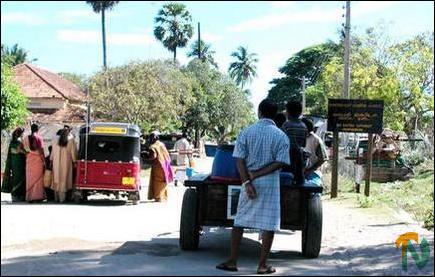
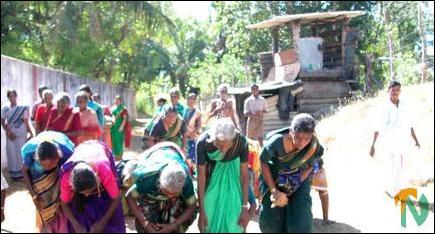 an SLA bunker in the Amman temple precincts
an SLA bunker in the Amman temple precincts














